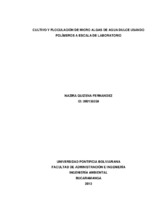Cultivo y floculación de micro algas de agua dulce usando polímeros a escala de Laboratorio
Fecha
2013Director/Asesor
Gamarra Hernández, Yolanda
Tipo de contenido
Práctica
Citación
Metadatos
Mostrar el registro completo del ítemDocumentos PDF
Resumen
Para identificar el floculante optimo, en cuanto a eficiencia de remoción de biomasa y ambientalmente amigable, teniendo en cuenta la afectación de la materia orgánica extracelular (EOM), se realizó harvesting en micro algas de agua dulce (Chlamydomonas reinhardtii PL16), por floculación, utilizando el polímeros catiónico natural quitosan y los polímeros catiónicos sintéticos FO 4990, FO 4550 y FO 4290, como agentes floculantes. Los resultados mostraron la afectación de la presencia de EOM en los cultivos, decreciendo la eficiencia de remoción de biomasa del medio, requiriendo así mayor cantidad de floculante para la remoción. En el caso de los polímeros sintéticos, fue requerido mayor nivel de cationicidad (%), para decrecer la dosis de floculante, en presencia de EOM. En ausencia de EOM no hubo una tendencia clara sobre la cantidad de polímero requerido, pero para el caso de los polímeros sintéticos, se necesitó, al menos tres veces menos de polímero fue requerido para lograr > 95 % de eficiencia de floculación. La dosis optima del quitosan para obtener eficiencias de floculación > 95 %, en la presencia y en la ausencia de EOM difiere solo por 20% (50 y 40 mg/L respectivamente). Las mejores condiciones de floculación fueron logradas con el polímero sintético FO 4990 a las dosis de 10 y 1 mg/L, en la presencia y ausencia de EOM respectivamente. El floculante más amigable con el medio ambiente fue el quitosan ya que se caracterizó por ser un biopolímero catiónico natural, no toxico, biodegradable, renovable, no corrosivo, fácil de tratar y aceptado ecológicamente. In order to identify the optimum flocculant in terms of removal efficiency and environmentally friendly, considering the effect of extracellular organic matter (EOM) was performed in harvesting of freshwater micro algae (Chlamydomonas reinhardtii PL16), by flocculation, using chitosan and synthetic cationic polymers FO 4990, FO 4550 y FO 4290. Showing the results, EOM significantly affect flocculation efficiency. In the presence of EOM, more flocculant is needed. Higher cationicity level (%) was required to decrease the amount of flocculant dosage in the presence of EOM. In the absence of EOM there was not a clear trend on the amount of polymer required, but for the synthetic polymers at least 3-fold less polymer was required to achieve > 95 % flocculation efficiency. The Chitosan dosage for > 95 % flocculation efficiency in the presence and absence of EOM differed only by 20 % (50 and 40 mg/L respectively). Best flocculation conditions were achieved with the synthetic FO 4990 polymer at a dosage of 10 and 1 mg/L in the presence and absence of EOM respectively and chitosan is the most environmentally friendly, since it is characterized by being a cationic natural biopolymer, non-toxic, biodegradable, renewable, non-corrosive, easy to deal with and accepted ecologically.
Palabra/s clave
Floculación
Algas
Polímeros
Cultiva de algas
Laboratorios
Colecciones
- Trabajos de grado [6698]
El ítem tiene asociados los siguientes ficheros de licencia:


